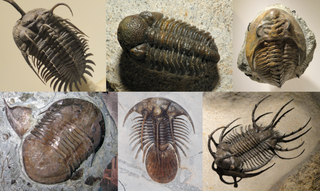
Trilobites are extinct marine arthropods that form the class Trilobita. Trilobites form one of the earliest known groups of arthropods. The first appearance of trilobites in the fossil record defines the base of the Atdabanian stage of the Early Cambrian period and they flourished throughout the lower Paleozoic before slipping into a long decline, when, during the Devonian, all trilobite orders except the Proetida died out. The last trilobites disappeared in the mass extinction at the end of the Permian about 251.9 million years ago. Trilobites were among the most successful of all early animals, existing in oceans for almost 270 million years, with over 22,000 species having been described.

Paradoxides is a genus of large to very large trilobite found throughout the world during the Middle Cambrian period. One record-breaking specimen of Paradoxides davidis, described by John William Salter in 1863, is 37 cm (15 in). The cephalon was semicircular with free cheeks ending in long, narrow, recurved spines. Eyes were crescent shaped providing an almost 360° view, but only in the horizontal plane. Its elongate thorax was composed of 19–21 segments and adorned with longish, recurved pleural spines. Its pygidium was comparatively small. Paradoxides is a characteristic Middle-Cambrian trilobite of the 'Atlantic' (Avalonian) fauna. Avalonian rocks were deposited near a small continent called Avalonia in the Paleozoic Iapetus Ocean. Avalonian beds are now in a narrow strip along the East Coast of North America, and in Europe.

Olenoides was a trilobite from the Cambrian period. Its fossils are found well-preserved in the Burgess Shale in Canada. It grew up to 10 cm long.
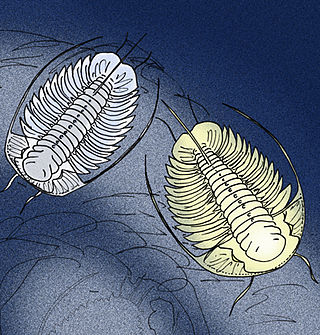
Balnibarbi is an extinct genus of trilobites in the family Olenidae. They are known from fossils excavated in Norway. They lived during the early part of the Arenig stage of the Ordovician Period, a faunal stage that occurred about 479 to 472 million years ago.
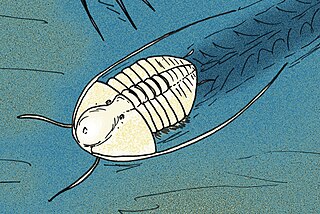
Globampyx is an extinct genus raphiophorid trilobites. It lived during the later part of the Arenig stage of the Ordovician Period, approximately 478 to 471 million years ago. Species of the genus are known from Canada, Norway (Svalbard) and Sweden.

Pytine is an extinct genus of asaphid trilobites. Species lived during the later part of the Arenig stage of the Ordovician Period, approximately 478 to 471 million years ago. Various species are found in the Svalbard, Valhallfonna Formation, Olenidsletta, Member, of Spitzbergen, Norway, the Megistaspis (Paramegistaspis) planilimbata Zone of the 'Shumardia Shale' of Sweden, Jujuy Province, Argentina, early Arenig-aged strata of Jiangxi province, China, and Darriwilian-aged strata in Western Hunan province, China. The type species, P. graia, has seven thorax segments, and lacks the rapier-like glabellar spine, that occurs in many other raphiophorids. The Chinese species, by contrast, have only six thoracic segments. So far, only the type species, and one of the Chinese species, P. laevigata, are known from complete specimens.

Lonchodomas is a genus of trilobites, that lived during the Ordovician. It was eyeless, like all raphiophorids, and had a long straight sword-like frontal spine, that gradually transforms into the relatively long glabella. Both the glabellar spine and the backward directed genal spines are subquadrate in section. Lonchodomas has five thorax segments and the pleural area of the pygidium has two narrow furrows. Lonchodomas occurred in what are today Argentina, Canada (Newfoundland), Estonia, Latvia, Norway, Sweden, the Russian Federation and the United States.
Mesolenellus is an extinct genus of trilobites that lived during the lower Cambrian (Botomian), found in Greenland and Spitsbergen.
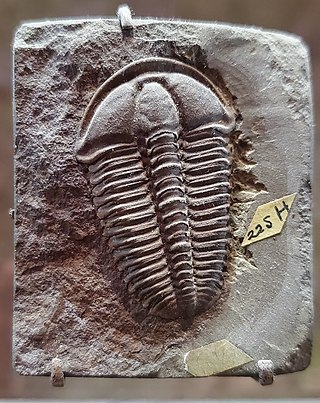
Conocoryphe is a genus of primarily eyeless trilobites belonging to the family Conocoryphidae. They lived during the Middle Cambrian period, about 505 million years ago. These arthropods lived on the sea bottom (epifaunal) and lived off dead particulate organic matter.

Trinodus is a very small to small blind trilobite, a well known group of extinct marine arthropods, which lived during the Ordovician, in what are now the Yukon Territories, Virginia, Italy, Czech Republic, Poland, Denmark, Sweden, Svalbard, Ireland, Scotland, Wales, Iran, Kazakhstan and China. It is one of the last of the Agnostida order to survive.

Cyclopygidae is a family of asaphid trilobites from the Ordovician. Cyclopygids had an extratropical distribution, and there is evidence that they lived in darker parts of the water column. Cyclopygids are characterized by enlarged eyes, with a wide angle of view, both horizontal and vertical, reminiscent of the eyes of dragonflies. These typically touch the glabella directly on the side. Cyclopygids all lack genal spines, but Symphysops carries a forward directed frontal spine on the glabella. It is presumed that at least the members of the genus Pricyclopyge swam upside down and had bioluminescent organs on the third thorax segment. Cyclopygids had between 7 and 5 thorax segments, a wide and stout axis, and short side lobes.

Pricyclopyge is a genus of trilobites assigned to the family Cyclopygidae that occurs throughout the Ordovician. Pricyclopyge had an extratropical distribution, and there is evidence that it lived in darker parts of the water column. Pricyclopyge has huge eyes, an inverted pear-shaped glabella, six thorax segments, with on the 3rd two small discs. Pricyclopyge is known from what are today China, the Czech Republic, France, and the United Kingdom.
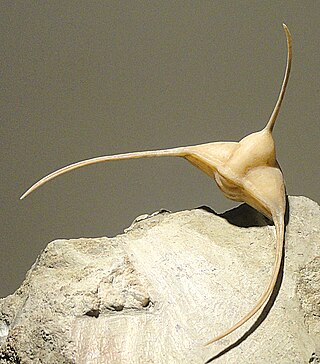
Raphiophoridae is a family of small to average-sized trilobites that first occurred at the start of the Ordovician and became extinct at the end of the Middle Silurian.
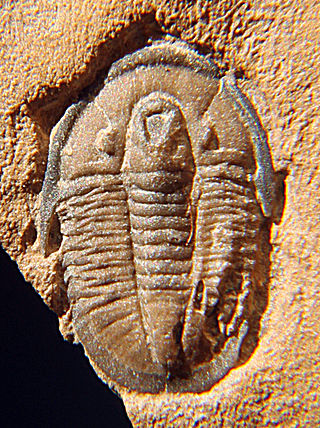
Cedaria is an extinct genus of trilobites from the late Cambrian.

Kendallina is a genus of parabolinoidid trilobite with an inverted egg-shaped outline, a wide headshield, small eyes, small deflected spines, 12 thorax segments and a small, short tailshield. It lived during the Late Cambrian in what are today Canada and the United States.

Genevievella is a genus of trilobites with a short inverted egg-shaped outline, a wide headshield, small eyes, and long genal spines. The backrim of the headshield is inflated and overhangs the first of the 9 thorax segments. The 8th thorax segment from the front bears a backward directed spine that reaches beyond the back end of the exoskeleton. It has an almost oval tailshield with 5 pairs of pleural furrows. It lived during the Upper Cambrian in what are today Canada and the United States.
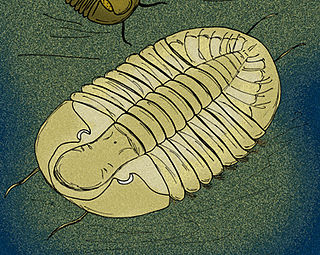
Gog is a genus of large, flattened asaphid trilobite from the Middle Arenig-aged Svalbard, Valhallfonna Formation, Olenidsletta, Member, of Spitzbergen, Norway, and the Upper Arenig-aged Dawan Formation in Hubei, China.

Telephinidae is a family of pelagic trilobites with large wide-angle eyes, occupying most of the free cheeks, downward directed facial spines and 9-10 thorax segments. The family is known during the entire Ordovician and occurred in deep water around the globe.

Entomaspididae is a family of harpetid trilobites that ranges from the Upper Cambrian to Lower Ordovician of marine strata in China and the United States.

Entomaspis is an extinct genus of harpetid trilobite from Upper Cambrian to Early Ordovician marine strata of the United States. Species are typified by their proportionally large, vaulted, croissant-shaped or bonnet-shaped cephalons that have the cheeks freed to become elongated, curved librigenial spines, and by their comparatively large, crescent-shaped eyes.
















